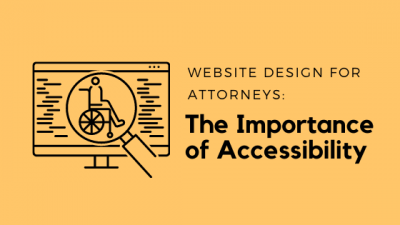Do Attorney Websites Need to Meet Accessibility Requirements?
 In the 21st century, we spend much of our lives online. However, while browsing websites, performing online searches or using mobile apps is a simple and easy process for most people, those who have disabilities often struggle to navigate the internet. Because of this, advocates for the disabled have worked to ensure that websites can be used by everyone, and in fact, some companies have even faced lawsuits for failing to provide accessible websites. By following accessibility guidelines during the website design process, law firms can avoid these issues and ensure that they can connect with potential clients with disabilities.
In the 21st century, we spend much of our lives online. However, while browsing websites, performing online searches or using mobile apps is a simple and easy process for most people, those who have disabilities often struggle to navigate the internet. Because of this, advocates for the disabled have worked to ensure that websites can be used by everyone, and in fact, some companies have even faced lawsuits for failing to provide accessible websites. By following accessibility guidelines during the website design process, law firms can avoid these issues and ensure that they can connect with potential clients with disabilities.
What Are Accessibility Guidelines?
The Americans with Disabilities Act (ADA) is the law that is most often used in cases related to website accessibility. Under the ADA, people with disabilities cannot be discriminated against in places of “public accommodation.” This is the basis for many of the lawsuits regarding website accessibility, since courts have found that websites fall into the category of places of public accommodation.
The ADA does not list technical standards for what makes a website accessible, but in many cases, the Web Content Accessibility Guidelines (WCAG) are used to determine whether a site can be used by those with disabilities. These guidelines were created by the World Wide Web Consortium (W3C) Web Accessibility Initiative (WAI), and they are regularly updated based on changes in technology, design trends, and any other issues that can affect the way people with and without disabilities use websites and digital technologies.
So what are these guidelines? They are a sort of checklist to make sure that anyone can use a website, including people with visual impairments who use tools that read the text on a site aloud and people with mobility issues who are unable to use some of the standard ways of navigating a site, such as a computer mouse or the touchscreen on a smartphone. Implementing these guidelines will not only make a website more usable, but it can also provide benefits for search engine optimization (SEO), since it will allow search engines to index a site, understand its content, and provide high-quality search results.
How Can I Make My Website Accessible?
Some of the key ways of ensuring that a website is accessible include structuring content properly and providing a clear way to navigate through a site. Accessibility should be addressed when initially designing a site and whenever new content is added. Some issues that may need to be addressed include:
- Using headings correctly - Different-sized headings can be used throughout the content on a website page, and these headings should be structured properly. H1 headings should be used for page titles, and other headings can be used in different sections of content. For instance, an H2 heading can introduce a section of a page, then H3 headings can mark subsections within that section. These headings and subheadings provide a structure that will help a person navigate through a page.
- Including image alt text - Images should include text that describes what is being depicted. This will allow anyone using a screen reader to understand how an image fits into the content of a page.
- Providing navigation tools - Users should be able to understand where they are in the structure of a site. Menus should clearly show how a person can access different pages and how those pages relate to other content. A sitemap should be included that shows how all of a site’s content is structured.
- Avoiding generic link text - When linking to other pages within a site or to external websites, the text of a link should describe what is being linked to, rather than using non-specific text such as “read more” or “click here.”
Contact Our Website Development and Marketing Experts
At OVC, INC., we make sure that the websites we design and build are fully accessible. In addition to implementing WCAG guidelines when building a site and writing and formatting content, we also provide a widget on the websites we build that offers tools for users with disabilities, allowing them to adjust the size of a site’s text, navigate a site using a keyboard, read a site’s content aloud, or make other necessary adjustments. To learn how we can help your law firm create an accessible website and a robust marketing strategy that will help you connect with clients and build your business, contact us at 630-635-8000.
Sources:
https://www.boia.org/blog/is-there-a-legal-requirement-to-implement-wcag
https://webaim.org/blog/web-accessibility-and-seo/
https://www.boia.org/blog/five-ways-to-improve-your-seo-with-web-accessibility






